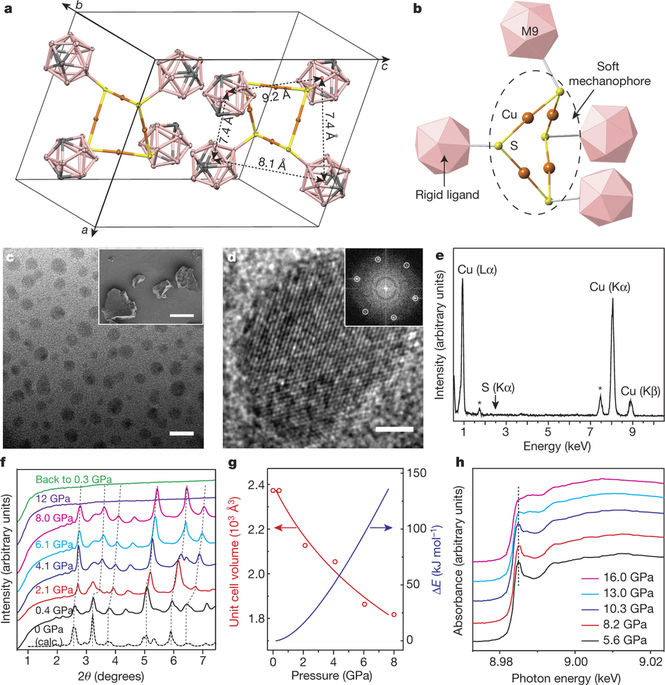Our official English website, www.x-mol.net, welcomes your
feedback! (Note: you will need to create a separate account there.)
Sterically controlled mechanochemistry under hydrostatic pressure
Nature ( IF 50.5 ) Pub Date : 2018-02-01 , DOI: 10.1038/nature25765 Hao Yan , Fan Yang , Ding Pan , Yu Lin , J. Nathan Hohman , Diego Solis-Ibarra , Fei Hua Li , Jeremy E. P. Dahl , Robert M. K. Carlson , Boryslav A. Tkachenko , Andrey A. Fokin , Peter R. Schreiner , Giulia Galli , Wendy L. Mao , Zhi-Xun Shen , Nicholas A. Melosh
Nature ( IF 50.5 ) Pub Date : 2018-02-01 , DOI: 10.1038/nature25765 Hao Yan , Fan Yang , Ding Pan , Yu Lin , J. Nathan Hohman , Diego Solis-Ibarra , Fei Hua Li , Jeremy E. P. Dahl , Robert M. K. Carlson , Boryslav A. Tkachenko , Andrey A. Fokin , Peter R. Schreiner , Giulia Galli , Wendy L. Mao , Zhi-Xun Shen , Nicholas A. Melosh

|
Mechanical stimuli can modify the energy landscape of chemical reactions and enable reaction pathways, offering a synthetic strategy that complements conventional chemistry. These mechanochemical mechanisms have been studied extensively in one-dimensional polymers under tensile stress using ring-opening and reorganization, polymer unzipping and disulfide reduction as model reactions. In these systems, the pulling force stretches chemical bonds, initiating the reaction. Additionally, it has been shown that forces orthogonal to the chemical bonds can alter the rate of bond dissociation. However, these bond activation mechanisms have not been possible under isotropic, compressive stress (that is, hydrostatic pressure). Here we show that mechanochemistry through isotropic compression is possible by molecularly engineering structures that can translate macroscopic isotropic stress into molecular-level anisotropic strain. We engineer molecules with mechanically heterogeneous components—a compressible (‘soft’) mechanophore and incompressible (‘hard’) ligands. In these ‘molecular anvils’, isotropic stress leads to relative motions of the rigid ligands, anisotropically deforming the compressible mechanophore and activating bonds. Conversely, rigid ligands in steric contact impede relative motion, blocking reactivity. We combine experiments and computations to demonstrate hydrostatic-pressure-driven redox reactions in metal–organic chalcogenides that incorporate molecular elements that have heterogeneous compressibility, in which bending of bond angles or shearing of adjacent chains activates the metal–chalcogen bonds, leading to the formation of the elemental metal. These results reveal an unexplored reaction mechanism and suggest possible strategies for high-specificity mechanosynthesis.
中文翻译:

静水压力下的空间控制机械化学
机械刺激可以改变化学反应的能量格局并启用反应途径,提供一种补充传统化学的合成策略。使用开环和重组、聚合物解链和二硫化物还原作为模型反应,在拉伸应力下的一维聚合物中广泛研究了这些机械化学机制。在这些系统中,拉力拉伸化学键,引发反应。此外,已经表明与化学键正交的力可以改变键解离的速率。然而,这些键激活机制在各向同性的压缩应力(即静水压力)下是不可能的。在这里,我们表明通过各向同性压缩的机械化学是可能的,分子工程结构可以将宏观各向同性应力转化为分子级各向异性应变。我们设计具有机械异质成分的分子——可压缩(“软”)机械团和不可压缩(“硬”)配体。在这些“分子砧”中,各向同性应力导致刚性配体的相对运动,各向异性地使可压缩机械团变形并激活键。相反,空间接触中的刚性配体阻碍相对运动,阻碍反应性。我们结合实验和计算来证明金属-有机硫族化物中静水压力驱动的氧化还原反应,其中包含具有异质可压缩性的分子元素,其中键角的弯曲或相邻链的剪切激活金属 - 硫属元素键,导致元素金属的形成。这些结果揭示了一个尚未探索的反应机制,并提出了高特异性机械合成的可能策略。
更新日期:2018-02-01
中文翻译:

静水压力下的空间控制机械化学
机械刺激可以改变化学反应的能量格局并启用反应途径,提供一种补充传统化学的合成策略。使用开环和重组、聚合物解链和二硫化物还原作为模型反应,在拉伸应力下的一维聚合物中广泛研究了这些机械化学机制。在这些系统中,拉力拉伸化学键,引发反应。此外,已经表明与化学键正交的力可以改变键解离的速率。然而,这些键激活机制在各向同性的压缩应力(即静水压力)下是不可能的。在这里,我们表明通过各向同性压缩的机械化学是可能的,分子工程结构可以将宏观各向同性应力转化为分子级各向异性应变。我们设计具有机械异质成分的分子——可压缩(“软”)机械团和不可压缩(“硬”)配体。在这些“分子砧”中,各向同性应力导致刚性配体的相对运动,各向异性地使可压缩机械团变形并激活键。相反,空间接触中的刚性配体阻碍相对运动,阻碍反应性。我们结合实验和计算来证明金属-有机硫族化物中静水压力驱动的氧化还原反应,其中包含具有异质可压缩性的分子元素,其中键角的弯曲或相邻链的剪切激活金属 - 硫属元素键,导致元素金属的形成。这些结果揭示了一个尚未探索的反应机制,并提出了高特异性机械合成的可能策略。


















































 京公网安备 11010802027423号
京公网安备 11010802027423号